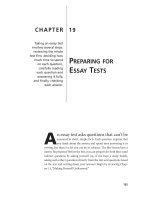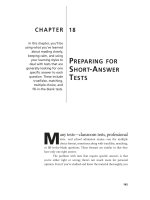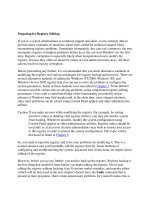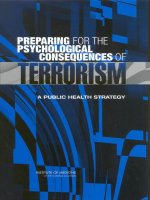Preparing for Short-Answer Tests
Bạn đang xem bản rút gọn của tài liệu. Xem và tải ngay bản đầy đủ của tài liệu tại đây (82.97 KB, 10 trang )
145
CHAPTER
18
P
REPARING FOR
S
HORT
-A
NSWER
T
ESTS
In this chapter, you’ll be
using what you’ve learned
about reading closely,
keeping calm, and using
your learning styles to
deal with tests that are
generally looking for one
specific answer to each
question. These include
true/false, matching,
multiple-choice, and
fill-in-the-blank tests.
M
any tests—classroom tests, professional
tests, and school admission exams—use the multiple
choice format, sometimes along with true/false, matching,
or fill-in-the-blank questions. These formats are similar in that they
have only one right answer.
The problem with tests that require specific answers is that
you’re either right or wrong; there’s not much room for personal
opinion. Even if you’ve studied and know the material thoroughly, you
Getting Over Test-Taking Obstacles
Tim and Tameka had been studying for exams that would qualify
them for promotions. They’d been studying for several months and
were confident they knew the material. As it got closer to test
time, they both began to panic because they knew they’d be given
a combination of different kinds of tests.
Tim told Tameka, “I think I can handle everything but fill-in-
the-blanks. I’m OK, if the right answer is there and I can find it, but
I’m really stuck if I have to come up with the name of something
on my own. I have trouble with names!”
Tameka said, “What about me? I get confused when I see a
bunch of answers that are similar to each other and I have to
choose the one that’s right. I say to myself, ‘Well, maybe under cer-
tain circumstances choice A would be correct, but then again,
choice B would work in a different situation.’ I do it every time!”
Tim has a problem coming up with the right names, and Tame-
ka has a problem when answer choices are very similar. What Tim
needs to do is learn to associate names with meanings, and Tame-
ka needs to come up with an answer before looking at the choices.
HOW TO STUDY
146
still may find some questions challenging. That’s because these tests are
often designed to be tricky: multiple-choice tests offer “close” answers in
addition to the correct one; matching tests use words out of context. So
in addition to knowing the subject matter, you’ve got to learn how to take
these kinds of tests, and this includes making up your own practice test.
STUDYING FOR A TEST
The best way to study for a test is to test yourself, or have your study
buddy test you.
T
ESTING
Y
OURSELF
Creating a test of your own forces you to think like a teacher. As you
develop questions, you hone in on what’s most important in what you’re
studying. This helps you understand the material better, and it gives you
more confidence in yourself. It also helps you become more responsible
for your own learning. When you make up a test like this, you are doing
PREPARING FOR SHORT
-
ANSWER TESTS
147
it for yourself; enjoy the feeling! Writing a test also helps you understand
how tests are made. This can make you more comfortable when you take
the real test.
T
ESTING WITH A
P
ARTNER
If you’re studying with a partner, make up a test for each other. Be sure
to make up answer sheets on separate paper and have proof for every
correct answer. If you’re studying from a pamphlet or book, for example,
cite the page number on which the answer can be found. When you and
your partner have completed each other’s test, swap. Check your
partner’s answers with your answer sheet and have him do the same. Go
over the answers for both tests together.
C
REATING
Q
UESTIONS
Getting Ready
First, pretend you’re the instructor.
Get a piece of paper, and:
1. List what you would want your students to get out of the course
or book. Write as many things as you can think of.
2. Circle three items that are most important to you. These three
items should represent the general idea of the course.
3. Circle two items that fall under each of your three main ideas.
These points should be more specific; they will concern details of
the course material.
4. Now you have nine items. Make each one into a question.
Questions for Your Study Buddy
If you’re preparing a test for a partner you can make up any of the four
types of short-answer questions. Multiple-choice questions may seem
difficult to create at first. Follow this formula for choices: make up four
possible answers for each question—a correct answer, a nearly correct
answer, an answer loosely associated with the right answer, and an answer
that is obviously wrong.
HOW TO STUDY
148
Questions for Yourself
Fill-in-the-blank questions can be used to help you learn definitions of
new vocabulary you encounter while studying. You can also prepare
multiple-choice, true/false, and matching questions to simulate the
actual test you’ll be taking. Although you’ll probably be able to answer
such questions easily since you made them up, the process of creating the
questions will give you new insights into correct answers—and help you
predict what tricks you’ll see on the real test.
Get a piece of paper and write the answers to the following questions.
If you tested yourself:
• What did you do to make up the test?
• Which was more comfortable for you, making the questions or
making the answers?
• Which answers were easiest to come up with?
If you worked with a partner:
• Which was more comfortable for you, creating the test or answering
your partner’s test?
• What did you do to complete the test?
• Which questions were easiest for you to answer?
P
ROCESS OF
A
SSOCIATION
As you study, try using large index cards for terms and ideas you could be
tested on. Write big so key words will stick in your mind. Use a different
color for each category. For instance, in a Spanish class, you might use
one color for the names of foods, another color for the names of kinds of
businesses, and a different color for the names of articles of furniture.
Next, come up with associations between these unfamiliar words
and ideas and things that are more familiar to you. Ask yourself, “What
does this word remind me of?” It all depends on you; whatever comes to
your mind works. The more unusual the association is, the more likely it
is to stick with you. Maybe it’s an image of something you see every day,
like a tree or a pancake. Or maybe it’s something a little stranger: perhaps
the word cognitive makes you think of a giant purple cog on top of a
Find Out!
PREPARING FOR SHORT
-
ANSWER TESTS
149
person’s head. Maybe it’s the name of a celebrity or politician. Maybe it’s
a configuration of numbers. Whatever your association is, write it on
your card with the term or idea you need to learn. Carry the cards with
you to review at opportune times—for instance, on the bus, on the
exercise bike, and while waiting in line.
• If you learn best by using images: Draw any images that you
associate with the information on each card. Use your imagination!
• If you learn best by seeing: Tape up your index cards in places
you can’t miss, for example, on the bedroom and bathroom mirrors
and by the front door. Use colors to highlight key words.
• If you learn best by hearing: Sing the words on your cards, even
if you’re not an opera star. This will make the association more
unique, and it will get another part of your brain operating. What
you sing stays with you longer than what you say.
There are probably other wacky but effective things you can do; use
your imagination. Only you think like you!
PREPARE YOURSELF FOR THE TEST
K
EEPING
C
ALM
Even before the test day there are things you can do to quell test anxiety.
You may want to review Chapter 1, “Getting Started,” for tips on keeping
calm. You feel calmer when you’re satisfied that you’ve studied as much
as possible. You may also want to review Chapter 7, “Knowing What You
Know,” for tips on making sure you’re as prepared as you think you are.
Eating nourishing meals will help; so does getting a good night’s sleep.
Shortly before taking the test:
• Imagine yourself in a soothing place. Close your eyes, and enjoy
the smells, sounds, and feelings of this out-of-the-way spot. It can
be a place you actually have been to, a place you’ve seen in a photo-
graph or movie, or somewhere that your imagination has created.









